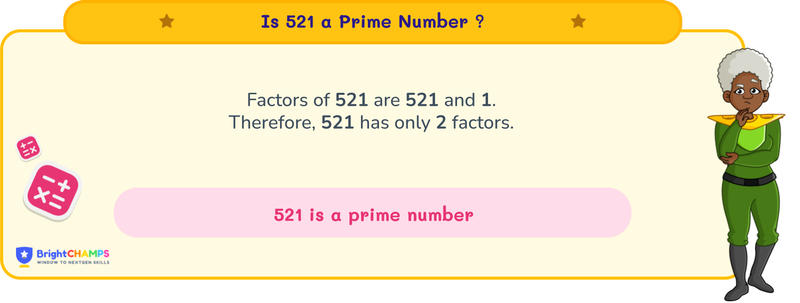
 165 Learners
165 LearnersLast updated on May 26th, 2025

Is 521 a Prime Number?

The numbers that have only two factors, which are 1 and itself, are called prime numbers. They play a critical role in various fields, including encryption, computer algorithms, and barcode generation. In this topic, we will be discussing whether 521 is a prime number or not.
Is 521 a Prime Number?
Numbers can be categorized as prime numbers or composite numbers based on their factors.
A prime number is a natural number that is divisible only by 1 and itself.
For example, 3 is a prime number because it is divisible by 1 and itself.
A composite number is a positive integer that has more than two factors.
For example, 6 is divisible by 1, 2, 3, and 6, making it a composite number.
Prime numbers have several properties, such as:
- Prime numbers are positive integers greater than 1.
- 2 is the only even prime number.
- They have only two factors: 1 and the number itself.
- Any two distinct prime numbers are co-prime numbers because they have only one common factor, which is 1.
Since 521 has only two factors, it is a prime number.

Why is 521 a Prime Number?
A prime number is characterized by having exactly two divisors: 1 and itself. Since 521 has only two factors, it is a prime number.
There are several methods to determine whether a number is prime or composite, such as:
- Counting Divisors Method
- Divisibility Test
- Prime Number Chart
- Prime Factorization
Using the Counting Divisors Method
The counting divisors method involves determining the number of divisors a number has to classify it as prime or composite.
- If there are exactly 2 divisors, then the number is prime.
- If there are more than 2 divisors, then the number is composite. Let’s check whether 521 is prime or composite.
Step 1: All numbers are divisible by 1 and themselves.
Step 2: Divide 521 by numbers up to its square root (approximately 22.8). It is not divisible by any other numbers.
Since 521 has exactly two divisors, it is a prime number.
Using the Divisibility Test Method
The divisibility test method involves using rules to check whether a number is divisible by another number without leaving a remainder.
Divisibility by 2: 521 is odd, so it is not divisible by 2.
Divisibility by 3: The sum of the digits in 521 is 8, which is not divisible by 3.
Divisibility by 5: 521 does not end in 0 or 5, so it is not divisible by 5.
Divisibility by 7: Applying the rule for 7 shows that 521 is not divisible by 7.
Divisibility by 11: Alternating sums do not give a difference divisible by 11.
Since 521 is not divisible by any number other than 1 and 521 itself, it is a prime number.
Using Prime Number Chart
The prime number chart is a tool created using "The Sieve of Eratosthenes." This method includes:
Step 1: Writing numbers from 1 to 1000 in rows and columns.
Step 2: Leaving 1 unmarked as it is neither prime nor composite.
Step 3: Marking 2 as prime and crossing out all its multiples.
Step 4: Continuing this process for the next unmarked number. Through this process, you'll find that 521 is a prime number since it does not appear as a multiple of any smaller prime number.
Using the Prime Factorization Method
Prime factorization involves breaking down a number into its prime factors. Once broken down, you multiply these factors to reconstruct the original number.
Step 1: Check divisibility by prime numbers smaller than the square root of 521.
Step 2: If no divisors are found other than 1 and 521 itself, the number is prime.
Since 521 cannot be broken down into smaller prime factors, it is a prime number.

Common Mistakes to Avoid When Determining if 521 is a Prime Number
There are common misconceptions about prime numbers that learners may encounter. Here are some mistakes:

FAQ on Is 521 a Prime Number?
1.Is 521 a perfect square?
2.What is the sum of the divisors of 521?
3.What are the factors of 521?
4.What are the closest prime numbers to 521?
5.What is the prime factorization of 521?
6.How can children in Singapore use numbers in everyday life to understand Is 521 a Prime Number??
7.What are some fun ways kids in Singapore can practice Is 521 a Prime Number? with numbers?
8.What role do numbers and Is 521 a Prime Number? play in helping children in Singapore develop problem-solving skills?
9.How can families in Singapore create number-rich environments to improve Is 521 a Prime Number? skills?
Important Glossaries for "Is 521 a Prime Number"
- Prime numbers: Natural numbers greater than 1 that have no divisors other than 1 and themselves.
- Composite numbers: Natural numbers greater than 1 that have more than two divisors.
- Divisibility Test: A method used to determine if one number is divisible by another without a remainder.
- Prime factorization: The process of expressing a number as the product of its prime factors.
- Sieve of Eratosthenes: An ancient algorithm used to find all prime numbers up to a specified integer.
Explore More numbers
About BrightChamps in Singapore


Hiralee Lalitkumar Makwana
About the Author
Hiralee Lalitkumar Makwana has almost two years of teaching experience. She is a number ninja as she loves numbers. Her interest in numbers can be seen in the way she cracks math puzzles and hidden patterns.
Fun Fact
: She loves to read number jokes and games.




